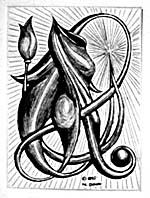 2-D Artwork
2-D Artwork
is, to me, a lot of fun and a definate challenge. It's not real, only an illusion when it's used to represent three dimensions, like in the print, "Quest." Three-dimensional artwork includes honest to God depth. You can see it and touch it, and it's there. My hands create sculpture and they know when it's right by how it looks and feels. Two-dimensional artwork uses things like tone and shading and shadows and color to make a viewer believe there is a third dimension that isn't really there. I find it a real challenge to accomplish this feat, and it's hard and very time consuming for me. Only recently have I felt that I am coming close to having a grip on this whole thing and turning out things that I still like after time.
What you'll see on this page are some of the drawings, prints and calligraphy I did while I was enrolled at Cabrillo College in Aptos, CA., so they aren't recent, but I'd sure like to take off from where I left off sometime. Time - too little of it, and we only find out the real value of it when there is so little of it left. The drawings are all graphite, other than "Young Love," which is colored pencil. The prints are all Intaglio prints, which are created by scribing, engraving, or acid etching a metal plate, usually zinc, but preferably copper, scraping ink into the incised areas, and cleaning it off the raised areas, and then laying a sheet of paper on it and running it through a press so the ink transfers to the paper, producing a print. The paper is embossed in the process, being slightly raised in the places where the press forced it down into the recessed areas - where the ink was.
Whereas graphite will give one a wide range of grays, you can't get a true black, so the best you can get will never have the "snap" to it that charcoal or ink have. So, to work within that restriction was a good teacher and it prepared me for working with ink in the printmaking end of things. Black ink, white paper, no shades of gray in-between. I learned to see a little differently, and represent shades of gray with texture density and roughness or hatching and stippling. Working with acid this is done by the amount of time in the acid bath - the longer, the rougher and darker it'd get. Puzzles, and a real interesting way to learn to work, as it's inside out and backwards when you are making and masking the lines in the plate.
The calligraphy was from a lettering class taught by Karl Rohrs, one of the top calligraphers on the planet. It's turned out to be a very useful tool to have to work with. The graphic design work has taken a life of it's own, and eventually evolved to what you see on this site.
I suppose that I should mention one other form of two-dimensional art that I do - digital art. That can be found on another set of pages and even though the end product is often a note card or print, it's true existence is in energy and states of being and electrical positioning prior to print. It doesn't really exist in the physical, material world until it's printed. Then it's a real thing, and a part of a two-dimensional family of the world of art. Still, I consider it as a separate form of art, and so that's why it's not a part of this cubbyhole on this site, and it gets a whole section of it's own.
Anyway, if you're still reading this, the pictures should have loaded by now, so go have a look. I still have a few prints left of the "Quest" edition (10) and the "Dancing Rose" edition (10) available. Email me if you're interested.
Thanks for your time.
|

